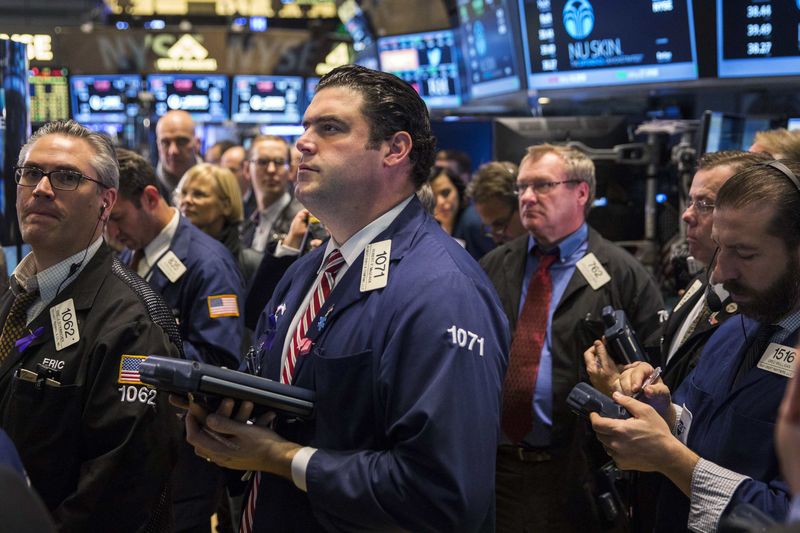* MSCI all world index eases 0.9 percent
* European share markets continue selloff
* Confusion over timing of trade truce, China commitments
* U.S. yield curve inversion raises recession concerns
* Dollar weakens, sterling bounces
By Laila Kearney
New York, Dec 4 (Reuters) - A key gauge of world equity markets fell on Tuesday as hopes faded for a speedy resolution to the U.S.-China trade spat, while a flattening Treasury yield curve sparked recession warning signs that weighed on the U.S. dollar.
Two-year Treasury yields rose above those of longer-dated 5-year notes overnight for the first time since the start of the financial crisis in January 2008, signalling to some investors an approaching U.S. economic slowdown. gauge of stock markets across the globe .MIWD00000PUS shed 0.90 percent, while the pan-European STOXX 600 index .STOXX lost 0.76 percent. market jitters added to a weak start on Wall Street.
The Dow Jones Industrial Average .DJI fell 255.16 points, or 0.99 percent, to 25,571.27, the S&P 500 .SPX lost 29.41 points, or 1.05 percent, to 2,760.96 and the Nasdaq Composite .IXIC dropped 94.53 points, or 1.27 percent, to 7,346.98.
On Monday, stock markets around the world got some relief after Washington and Beijing agreed to temporarily end their trade war during talks at the G20 summit in Argentina. Upon closer scrutiny, investors said a deal between the world's two biggest economies was far from a sure bet.
"It isn't very clear on what both sides agreed to, other than just a temporary truce," Scott Brown, chief economist at Raymond James in St. Petersburg, Florida said.
There was added confusion over when the 90-day truce period, during which the U.S. and China would hold off on imposing more tariffs, would start. none of the commitments that U.S. officials said had been given by China - including reducing its 40 percent tariffs on autos - were agreed to in writing and specifics had yet to be hammered out. the flattening U.S. yield curve weighed on investors' minds.
"The focus is now shifting to the inverted U.S. bond yield curve, which has negative connotations, while implying the U.S. economy is heading towards what was, only a few weeks ago, an improbable economic slowdown," said Stephen Innes, head of trading for APAC at Oanda.
The spread between two-year and three-year yields US2US3=TWEB was -0.10 basis point in morning trading, marking the first yield inversion between these two maturities since January 2008, according to Tradeweb and Refinitiv data.
The U.S. dollar sagged as Treasury yields fell, adding to concerns the Federal Reserve could pause in its rate-hike cycle. greenback, which started the week on a weak footing as the apparent thaw in trade tensions between the U.S. and China cooled demand for the safe-haven currency, extended its fall as investors worried about the inversion of the short end of the U.S. yield curve in bond markets.
The dollar index .DXY , tracking the unit against six major world currencies, fell 0.12 percent, with the euro EUR= down 0.08 percent to $1.1343. The dollar fell half a percent against the offshore yuan CNH= to 6.8441, its weakest since September.
Sterling rose after a senior European Union legal adviser said Britain could unilaterally withdraw its Brexit notice, easing investors concerns about Britain crashing out of the bloc in March without a deal.
Oil prices surged, extending gains ahead of expected output cuts by producer cartel OPEC and a reduction in Canadian supply.
Brent crude oil LCOc1 jumped by $1.89, or 3 percent, to a high of $63.58 before slipping back to trade around $62.25, up 56 cents by 1425 GMT. U.S. light crude CLc1 was last up 20 cents at $53.15 after earlier gaining more than 3 percent to an intraday high of $54.55 a barrel. O/R
<^^^^^^^^^^^^^^^^^^^^^^^^^^^^^^^^^^^^^^^^^^^^^^^^^^^^^^^^^^^ U.S. yield curve inversion
https://tmsnrt.rs/2RvJ6J5
^^^^^^^^^^^^^^^^^^^^^^^^^^^^^^^^^^^^^^^^^^^^^^^^^^^^^^^^^^^>
